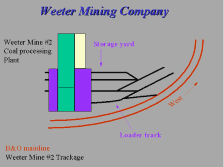
Instructions for yard crew, Weeter Mining Company – Weeter Mine #2.
Processing of incoming trains
Empties returning to the mine are handled in the following manner.
- Check that the yard lead is clear. Sufficient capacity must exist to absorb the incoming
train into the track which passes besides, behind, and around the mine.
- Make sure the yard engine is in the clear on the scale or tipple leads.
- The road crew will cut their caboose, pull ahead of the switch, and back the train into
the yard lead. Once the coupler of the trailing unit is clear of the yard lead switch, the
road power will disconnect, return to the main and pick up their caboose. The Valley
Dispatcher controls the yard lead, and mainline switches.
- The yard engine will couple to the cut of empties, and begin storing them one at a time
on one of the two storage tracks. Keep in mind that the cab of the yard engine is not
permitted to pass under the mine structure itself.
- Remember to use cars as a handle whenever possible. This is especially important when
working with cars that are beyond the mine in the tunnel.
Loading and make-up of outbound trains
Trains will be made up for departure in the following manner.
- Trains are made beginning with the last car of the train. When possible, cars of lighter
capacity (typically two bay cars) should be placed at the rear of the train.
- Cars are loaded under the tipple on their way to the yard lead. Cars should be full, but
not overflowing. After a car is filled it is moved to the yard lead.
- Cars moved to the yard lead, should be pushed back toward the tunnel as much as
possible. This is because the train weight will increase sufficiently to the point where
the yard engine will not be able to move the entire cut. Plan to build a 9 or 10 car
train. When the capacity of the track between the yard lead switch and the B&O
mainline retaining wall is insufficient to store the remaining cars on the train, ensure
that the entire cut is pushed back to the retaining wall.
- Important! Be sure to do your paperwork as the train is built. Many employees have
realized after building a train, that they must now walk the tunnel with flashlight in
hand to read car numbers! Do your paperwork for each car to avoid this problem. The tunnel
is damp, quarters are tight, and men have been injured when venturing within.
- Notify the Valley Dispatcher when you are 80% finished with building the outbound. This
will allow time for crew calling, and power to be dispatched to pick up the train.
Considerations
- The tipple holds roughly one train load of coal before it requires servicing from the
miners. You will know you’ve done a good job when the last car is nearly full, and
you run out of coal. Notify the Valley Dispatcher when the mine runs dry. The release of
coal is controlled by the red button. Advance notice of the depletion of coal can be
obtained by observing the movement of coal through the clear discharge chute between the
storage bin and the crusher.
- The pedal on the floor controls power to the mine. It should be off, whenever the mine
is unattended. The pedal is operated by pressing it with the foot, and releasing it. Each
depression cycles power to the mine.
- All switches in the yard are powered with the exception of half of the 3-way switch
which is not powered in one direction only. This must be manually operated at this time.
The Green and Yellow buttons throw all switches simultaneously.
- Due to coal dust, the condition of the locomotive can deteriorate. If this occurs,
notify the Berkeley Springs Roundhouse foreman, who will dispatch a replacement unit.
Usual power for the mine is WMC Alco S2 number 1025, or MV EMD SW-1500 number 947. Both
units are equipped with safety strobes that must be on during operation. These strobes are
operated using Function 1 on the Dynamic Consist Control console.
- If it is necessary to introduce the use of a "non-scale, semi automated
object" such as a finger into any aspect of the operation of this facility, please
observe all current Moose Valley gentlemen’s rules.



